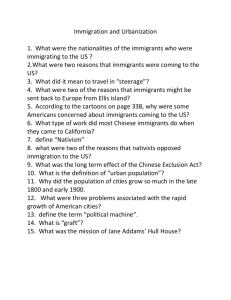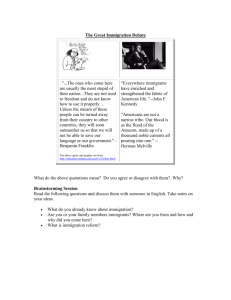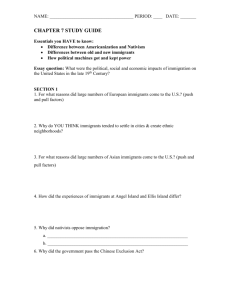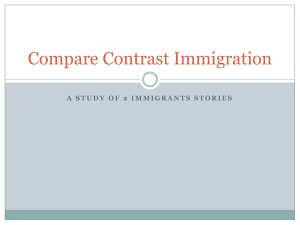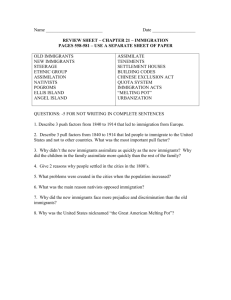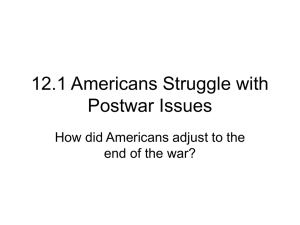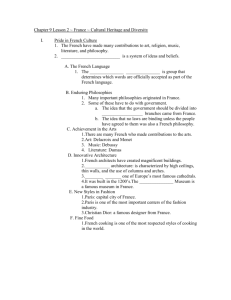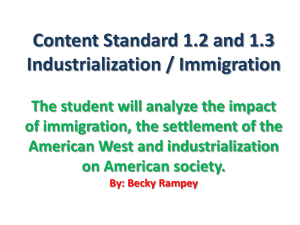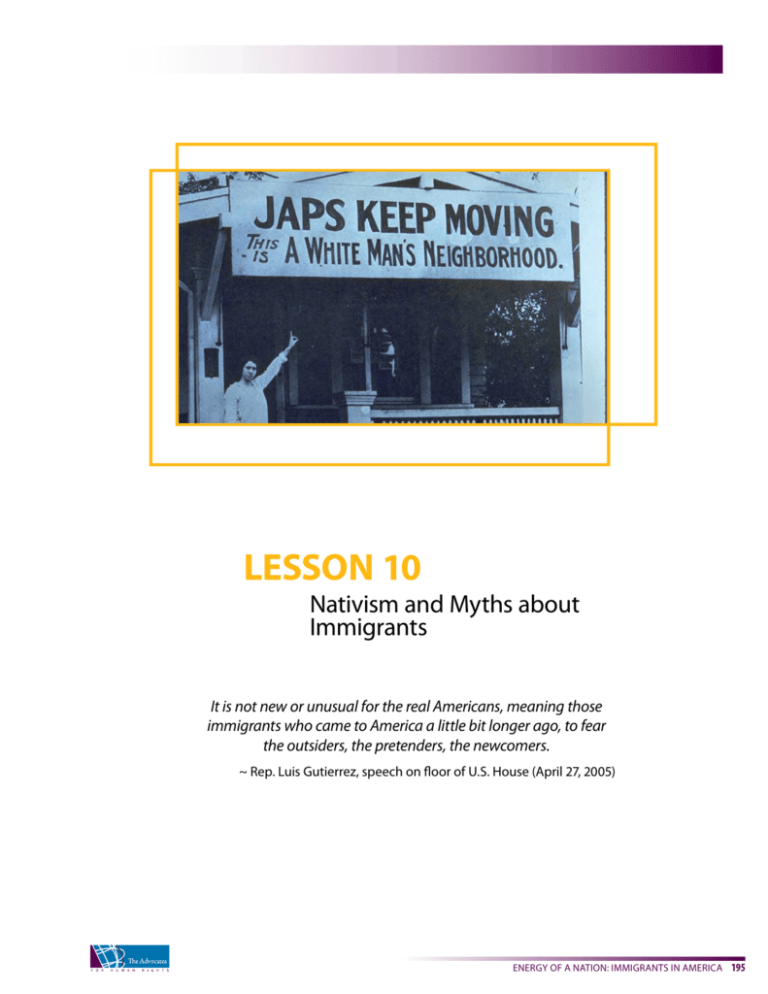
LESSON 10
Nativism and Myths about
Immigrants
It is not new or unusual for the real Americans, meaning those
immigrants who came to America a little bit longer ago, to fear
the outsiders, the pretenders, the newcomers.
~ Rep. Luis Gutierrez, speech on floor of U.S. House (April 27, 2005)
ENERGY OF A NATION: IMMIGRANTS IN AMERICA 195
LESSON
10
Nativism and Myths
about Immigrants
Goals
Materials
» Understand nativism and anti-immigrant prejudice in U.S.
history and relate it to present-day movements.
þ Handout 1: Fact, Myth, or Opinion
» Learn how to recognize myths and find accurate information to
refute them.
þ Handout 3: Nativism in U.S.
History Timeline
Objectives
þ Handout 2: Gallery of Nativism
þ Handout 4: Guide to Sources
» Students will learn to distinguish between fact, myth, and
opinion.
þ Tape (for 10 groups), colored
paper
» Students will understand why myths about immigrants are
created and spread.
þ Scissors
» Students will recognize nativism as a recurring problem in U.S.
history that still exists today.
» Students will learn how to evaluate the accuracy of information
about immigrants in the United States.
Essential Question
» Where do anti-immigrants myths come from, and how can I
refute them?
Key Skill
» Critically analyzing media and identifying reliable sources
(Activity 2 & 3).
Teacher Advisory
Some of the images and quotes in this lesson are racist and
disturbing, but are included for historical understanding. Please
warn your students and offer them an opportunity to discuss their
reactions. All dialogue should be respectful.
Additionally, please read the Advisory on Immigration Status on
page 20 before beginning this lesson.
196 ENERGY OF A NATION: IMMIGRANTS IN AMERICA
þ Sticky notes (optional)
Time Frame
3-4 class periods
Vocabulary
! bias
! fact
! myth
! native-born
! nativism
! nativist
! opinion
! reliability
1
Lesson 10: Nativism and Myths about Immigrants
ACTIVITY 10.
Spot the Myths
Procedure:
1. Prepare. Cut out the cards (being careful not to include the answers) from Handout 1: Fact, Myth, or
Opinion and set them aside.
2. Think. Ask students to define the terms “fact,” “myth,” and “opinion.” Explain that opinions reflect
personal beliefs, but they are often based on information a person has read, heard, or seen. The information
on which we base our opinions may be true (a fact) or false (a myth).
Further explain that the opinions we hold have consequences on the human rights and daily lives of
immigrants. Opinions that are based on negative myths or false information can be very harmful. Draw a
shorthand version of the following sequences on the board.
Fact: Immigrants
today learn English
at the same rate or
faster than they did
in the past. Learning
a new language takes
time; more ESL classes
are needed in many
communities.
Myth: Immigrants
today aren’t learning
English as fast as
our ancestors did.
Historically, the
government did not
translate materials into
other languages.
Opinion:
Immigrants are
motivated and
need better access
to English classes.
Result: Volunteers teach
ESL classes through a local
community education
program. Ten adult Somali
refugees expand their
vocabulary and improve their
writing skills.
Opinion:
Immigrants do not
want to learn or
speak English. They
should be required
to learn it, like I
would if I were in
another country.
Result: A voter demands an
English-only city ordinance
to stop printing public
materials in other languages.
Months later, a mother
bringing her child to a city
park cannot read the posted
rules and warnings about the
equipment.
3. Identify. Divide students into small groups of three or four. Give each group one card from Handout 1:
Fact, Myth, or Opinion. Go over the example card about human rights as a class, having students vote on
which statement they think is fact, myth, or opinion before revealing the answers. Have the small groups
repeat the process with the statements on their cards. After they have finished, have the groups share their
answers with the class, and then tell them how their results compare to the real answers.
4. Discuss. After students have correctly identified the fact, myth, and opinion about immigration, have the
small groups discuss the following questions:
Questions for Discussion
?
How or why do you think the myth on your card started?
?
Is the opinion based on the myth or the fact on your card?
?
How might the opinion impact the human rights of immigrants?
ENERGY OF A NATION: IMMIGRANTS IN AMERICA 197
2
Lesson 10: Nativism and Myths about Immigrants
ACTIVITY 10.
A History of Nativism
Procedure:
1. Prepare. Print out all pages from Handout 2: Gallery of Nativism. Cut out the date range cards and hang
them around the classroom in chronological order. Group the images and quotes by their respective
historical periods (Early American Intolerance, Anti-Catholicism, etc.). (Note: If you can have students cut
them out, it will save time.)
2. Define. Explain that negative myths about immigrants are often created and spread by people known
as nativists. Ask students what they think the term nativism might mean. Provide them with the following
definition:
! Nativism: the policy or practice of prejudice against immigrants in favor of the native-born, established
inhabitants of a country.
Point out that the meaning of “native inhabitants” in this definition is not Native Americans, but instead
whatever group is the hegemony currently residing in the United States when a new, distinctive group of
immigrants arrive.
Teacher Tip
Be sensitive to the fact that some students may be the target of some of
current myths and stereotypes. You may wish to assign new immigrant
students to some of the earlier time periods for the first part of the exercise.
3. Create the gallery. Divide the class into ten groups (2-4 students in each group). Give all students
Handout 3: Nativism in U.S. History Timeline. Also give each group one or two pieces of colored paper and one
of the sets of images and quotes from a particular time period, created in Step One: Prepare. Explain that the
class is now going to be creating a “Gallery of Nativism” around the classroom. Tell students that each group
should use the information in their handouts to create a sign (with the information below) and a collage
(made up of the images and quotes from their time period) for their section of the gallery. Tell them to tape/
glue the images and quotes to the colored sheet/s of paper, and have them get out a sheet of paper and
write the following information on their signs:
the immigrant group being targeted;
the main stereotypes, myths, or prejudice being perpetuated; and
possible reasons why nativism occurred at that time.
Let students know that some of the time periods overlapped, and that there were resurgences in prejudice
against certain groups. The date ranges provided reflect the most intense anti-immigrant sentiment toward
a particular group. When they have finished their sign, each group should find the relevant time period and
hang their quotes, images, and write-up on the wall.
4. Walk the gallery. Now have the class walk around the timeline and write down the myths about
immigrants that appear more than once in the timeline. You can choose to have the class walk it
independently or together, taking turns having a representative from each group give a brief summary of
their time period as they go along.
(continued on next page)
198 ENERGY OF A NATION: IMMIGRANTS IN AMERICA
2
Lesson 10: Nativism and Myths about Immigrants
ACTIVITY 10.
A History of Nativism
(continued from previous page)
5. Discuss. Bring the class back together to discuss what they learned from the timeline. Have students first
share anything they found particularly surprising or disturbing. Next, ask them to share the myths that they
saw repeated at different eras and with different immigrant groups. Use the following questions to explore
what might lead to the same anti-immigrant myths appearing repeatedly throughout U.S. history.
Questions for Discussion
?
Was this exercise disturbing for you? Were you surprised by the levels of animosity?
?
What are some common myths, stereotypes, or prejudices about immigrants that appear
many times for different immigrant groups?
?
Why would the same myths be applied to immigrant groups from very different countries
and cultures?
?
Are the groups that are considered “native” in a particular time period always the same? Are
the “natives” of the 1790s the same as the “natives” of today?
?
Do we still apply the anti-immigrant myths, stereotypes, or prejudices used in the past to the
same ethnic or cultural groups today? For instance, do people still think that Irish-Americans
or German-Americans will never learn English? What changed?
?
Are anti-immigrant myths today similar to ones from the past, even though they target
different ethnic and cultural groups? Why or why not?
?
Why would someone create or spread anti-immigrant myths, stereotypes, or prejudices? What
purpose do they serve?
?
How is nativism a reaction to feeling threatened, and why do we feel threatened by
immigration?
?
How do you think these myths, stereotypes, or prejudices affected the human rights of
immigrants over the years?
?
How would you feel if you were the target of one of these myths?
ENERGY OF A NATION: IMMIGRANTS IN AMERICA 199
3
Lesson 10: Nativism and Myths about Immigrants
ACTIVITY 10.
Challenging Myths
Procedure:
1. Brainstorm. Explain that many times, when people hear a piece of information, they do not know
whether it is true or not, and so they believe anything that matches what they already think and reject new
ideas. Instead of relying on our instincts, which can be wrong, it would be better if people tried to find out
from reliable sources if the new information they heard is a fact or a myth.
Ask students to give an example of a rumor that might be told about a person or group of people. How
could they figure out if the rumor is true or not? If the rumor is not true, how could they stop it? Write down
their ideas on the board.
Just as there are ways to stop rumors at school or among friends, people can also stop anti-immigrant myths
through these three steps:
Question new information that you hear or read, instead of just accepting it as true.
Go to reliable sources to verify the information.
If the information is untrue, speak up when you hear the myth and make an effort to spread the truth.
2. Question. Have students revisit the myth from their fact, myth, and opinion card. Pose the following
question to students: “If you had never seen this myth before, how could you try to find out if it was a
fact or a myth?” Explain that one way to find out the truth is to seek out reliable sources of information.
For this exercise, they will be provided with a trustworthy source. Have students go online and access the
Immigration Policy Center’s 2010 report “Giving Facts a Fighting Chance,” which can be found with a simple
Google search.1
Have students look for the section of the report that relates most closely to their myth and then read the
section in its entirety for facts that disprove their myth and for more information about the topic. Have them
write down any original sources they find (e.g., “The National Research Council reported that…”) and why
they think the sources may or may not be reliable.
3. Check. Pass out Handout 4: Guide to Sources. Have students read through it, then go over the main points
with them as a class. Allow them to ask questions about vocabulary or ideas they do not understand. Next,
ask students to form pairs (with a student not from their original Fact, Myth, and Opinion group) and use
the credibility checklist on Handout 4 to determine the reliability of the sources they found in “Giving Facts
a Fighting Chance.” When they are finished, have groups share what reliability criteria matched the sources
they found.
4. Make the connection. Explain that part of the reason it is important to find reliable sources is that
sometimes myths are intentionally spread by people with hidden agendas. In the case of immigration,
much of the misinformation and ill feelings spread in the media and elsewhere originate from nativist
organizations. Many modern anti-immigrant myths, stereotypes, and prejudices are sustained through
a highly organized network of groups with distinct messages and audiences that are designed to look
independent, but in fact share funding, resources, supporters, founders, key leaders, and tactics. Some of
these founders and supporters hold controversial or even racist views on immigration, and some have been
connected to white supremacist groups.
(continued on next page)
1
To access the report directly, go to http://immigrationpolicy.org/sites/default/files/docs/Brief22%20-%20Endless%20
Wait.pdf.
200 ENERGY OF A NATION: IMMIGRANTS IN AMERICA
3
Lesson 10: Nativism and Myths about Immigrants
ACTIVITY 10.
Challenging Myths
(continued from previous page)
Have students study the map created by the Center for New Community to show all the anti-immigrant
organizations connected to this network (found at www.newcomm.org/pdf/CNC-Tanton_Network_2009.pdf).
Point out the variety of niches that the network fills. For example, FAIR has established itself as an expert
group; the Center for Immigration Studies describes itself as a think tank and provides data that it and FAIR
frequently use in the media; ProEnglish provides template language for city councils to pass English-only
policies (see www.energyofanation.org/English-only_ordinance_in_mn.html for an example); and there are
many local groups that have sprung up as smaller affiliates of FAIR that feed off of its information and tactics.
As a class, discuss some of the potential problems and implications of this anti-immigrant network.
Questions for Discussion
?
Do you think that it matters that these groups have connections to white supremacist or racist
people or organizations? What if they only receive money from such groups?
?
Some of these organizations have publicly distanced themselves from the most controversial
founders and leaders in the network. Do you think that their credibility is still in question?
?
Should people know the background of these organizations when reading or hearing the facts
and opinions they provide?
?
Until recently, most people did not know about this anti-immigrant network. Why do you think
that is?
?
Do you think something should be done to counter myths started or perpetuated by nativist
groups? If so, what?
5. Practice. Explain to students that it can seem discouraging to learn about the
long history of nativism in the United States that is still being sustained today by
an influential network of anti-immigrant organizations. However, remind students
that previous cycles of nativism have been overcome by people willing to stand
up and tell the truth when confronted by anti-immigrant myths and stereotypes.
It can be difficult or intimidating to challenge someone who is repeating incorrect
information, so students will get now a chance to practice refuting a myth.
Have students return to the pairs they were in when they checked the reliability of
their sources. Have the students take turns practicing refuting a myth. One student
should read one of the myths they originally researched, as if they were telling a
friend or family member something they just learned (e.g., “It makes me so mad
that...” or “Did you hear that immigrants...?”). The other student should reply using
the fact that they discovered that refutes the myth (e.g., “That’s not actually true.
Did you know...?” or “That’s a common myth about immigrants, but the reality is...”).
After one exchange, the students should switch roles and refute the other myth.
If students created the “Gallery of Nativism” in Activity 2, one powerful end to the lesson is for each student
to write down the statement they practiced refuting an anti-immigrant myth on a sticky note (or write down
another action they can take to refute myths and bias). Students can then take their sticky notes and cover up
one of the images or quotes that they found particularly offensive in the gallery.
ENERGY OF A NATION: IMMIGRANTS IN AMERICA 201
Lesson 10: Handout 1
FACT, MYTH, OR OPINION
CARDS
ANSWERS
EXAMPLE – Human Rights
Human rights include family unity, access to just working conditions, and freedom from
discrimination on the basis of national origin for everyone.
People who immigrate illegally should not be guaranteed any rights.
Fact
Opinion
Myth
Only documented immigrants have human rights.
#1 – Economy
Immigrants help improve the U.S. economy, adding over $37 billion to the gross domestic
product (GDP) each year.
Immigrants are a drain on the economy.
Fact
Myth
I think the U.S. needs immigrants to be prosperous.
Opinion
#2 – Undocumented Immigration
Undocumented immigrants could come legally, they just don’t want to.
Myth
Many people have no way to legally immigrate to the U.S., because there are very few visas
for low-skill workers, and wait times for family members can stretch for decades.
Fact
I think the immigration system should be changed so more people can immigrate legally if
they want to.
Opinion
#3 – Integration
Immigrants should only be allowed into the country if they already speak English.
Opinion
By the second generation, nearly all (98%) immigrants know English.
Fact
There is less of a need to learn English now, so immigrants stay within their own communities
and speak their own languages.
Myth
Source: “Giving Facts a Fighting Chance: Answers to the Toughest Immigration Questions,” Immigration Policy Center,
American Immigration Council, Oct. 12, 2010, http://www.immigrationpolicy.org/special-reports/giving-facts-fighting-chance-answerstoughest-immigration-questions.
202 ENERGY OF A NATION: IMMIGRANTS IN AMERICA
© 2012 The Advocates for Human Rights. All Rights Reserved.
Reproduction for educational use permitted. www.energyofanation.org
Lesson 10: Handout 1
FACT, MYTH, OR OPINION
#4 – Immigration Enforcement
Having local police enforce immigration law leaves immigrants too frightened to report
crimes or serve as witnesses, making communities less safe.
Fact
Everyone, including individuals and local police officers, should be part of the effort to get rid
of undocumented immigrants.
Opinion
If someone knows their neighbor is undocumented, they are legally obligated to call the
police.
Myth
#5 – Crime
New immigrants are more likely to be criminals than native-born residents.
Myth
Opinion
My neighborhood is lucky that several immigrant families are moving in.
Immigrants’ incarceration rate is five times less that of the native-born population.
Fact
#6 – Taxes
Immigrants do not pay taxes.
Myth
Even undocumented immigrants pay taxes. The majority pay income tax, and everyone pays
sales and property taxes.
Fact
Immigrants are enjoying services that are paid for with my tax money, and they should be
fined because they are not contributing otherwise.
Opinion
#7 – Benefits
I think that immigrants who are hardworking and law abiding should not have to struggle so
hard to make ends meet because of a lack of social benefits.
Opinion
Immigrants are bankrupting public benefit systems.
Undocumented immigrants are not eligible for food support, Social Security, or Medicaid. In
fact, they are restricted from all public benefits, except from emergency medical care in the
case of life-threatening situations.
Myth
Fact
Source: “Giving Facts a Fighting Chance: Answers to the Toughest Immigration Questions,” Immigration Policy Center,
American Immigration Council, Oct. 12, 2010, http://www.immigrationpolicy.org/special-reports/giving-facts-fighting-chance-answerstoughest-immigration-questions.
© 2012 The Advocates for Human Rights. All Rights Reserved.
Reproduction for educational use permitted. www.energyofanation.org
ENERGY OF A NATION: IMMIGRANTS IN AMERICA 203
Lesson 10: Handout 2
GALLERY OF NATIVISM
Early American Intolerance
Pre-1830
Anti-Catholicism
Mid- to Late 19th century
(1830-1860s)
Chinese Exclusion
Late 19th century
(1870-1890s)
Americanization Campaign
Late 19th century/Early 20th century
(1890-1920)
World War I
Early 20th century
(1910-20)
204 ENERGY OF A NATION: IMMIGRANTS IN AMERICA
© 2012 The Advocates for Human Rights. All Rights Reserved.
Reproduction for educational use permitted. www.energyofanation.org
Lesson 10: Handout 2
GALLERY OF NATIVISM
Ethnic Quotas
Mid-20th century
(1920s-30s)
World War II
Mid-20th century
(1940s-50s)
English-only Movement
Late 20th century
(1980s-present)
Undocumented Immigration
Late 20th century/Early 21st century
(1990s-present)
Post-September 11
Early 21st century
(2001-present)
© 2012 The Advocates for Human Rights. All Rights Reserved.
Reproduction for educational use permitted. www.energyofanation.org
ENERGY OF A NATION: IMMIGRANTS IN AMERICA 205
Lesson 10: Handout 2
GALLERY OF NATIVISM
Early American Intolerance
[Regarding the Germans] “....Those who come hither are
generally of the most ignorant Stupid Sort of their own
Nation. Few of their children in the Country learn English …
the Signs in our Streets have inscriptions in both languages,
and in some places only German … I suppose in a few years
they [interpreters] will be also necessary in the Assembly, to
tell one half of our Legislators what the other half say … they
will soon so out number us, that all the advantages we have
will not in My Opinion be able to preserve our language, and
even our Government will become precarious.”
~ Benjamin Franklin, “A Letter to Peter Collinson,” May 9, 1753
Benjamin Franklin
“Do we not know that the French nation have organized
bands of aliens as well as of their own citizens, in other
countries, to bring about their nefarious purposes … By
these means they have overrun all the republics in the
world but our own.”
~ Representative Harrison Otis, statement on floor of U.S.
House of Representatives, June 1798
“Why should Pennsylvania, founded by the English, become a
Colony of Aliens, who will shortly be so numerous as to Germanize us
instead of our Anglifying them, and will never adopt our Language
or Customs, any more than they can acquire our Complexion.
Which leads me to add one Remark: That the Number of purely
white People in the World is proportionably very small … in Europe,
the Spaniards, Italians, French, Russians and Swedes, are generally of
what we call a swarthy Complexion; as are the Germans also … And
while we are, as I may call it, Scouring our Planet, by clearing America
of Woods, and so making this Side of our Globe reflect a brighter
Light to the Eyes of Inhabitants in Mars or Venus, why should we in
the Sight of Superior Beings, darken its People? why increase the
Sons of Africa, by Planting them in America, where we have so fair an
Opportunity, by excluding all Blacks and Tawneys, of increasing the
lovely White and Red? But perhaps I am partial to the Complexion of
my Country, for such Kind of Partiality is natural to Mankind.”
~ Benjamin Franklin, “Observations Concerning
the Increase of Mankind, Peopling of Countries, etc,” 1751
President John Adams
206 ENERGY OF A NATION: IMMIGRANTS IN AMERICA
© 2012 The Advocates for Human Rights. All Rights Reserved.
Reproduction for educational use permitted. www.energyofanation.org
Lesson 10: Handout 2
GALLERY OF NATIVISM
Anti-Catholicism
“The Roman Catholic Church claims infallibility for
itself, and denies Spiritual Freedom, Liberty of Mind or
Conscience to its members. It is therefore the foe to all
progress ; it is deadly hostile to Democracy. She is the
natural ally of tyrants, and the irreconcilable enemy of
Freedom.”
~ Theodore Parker, “A sermon of the dangers which
threaten the rights of man in America,” July 2, 1854
“If the potentates of Europe have no design
upon our liberties, what means the paying
of the passage and emptying out upon our
shores of such floods of pauper emigrants—
the contents of the poor house and the
sweepings of the streets—multiplying
tumults and violence, filling our prisons, and
crowding our poor houses, and quadrupling
our taxation, and sending annually
accumulating thousands to the polls to lay
their inexperienced hand upon the helm of
our power?”
~Beecher, “A Plea for the West”
© 2012 The Advocates for Human Rights. All Rights Reserved.
Reproduction for educational use permitted. www.energyofanation.org
ENERGY OF A NATION: IMMIGRANTS IN AMERICA 207
Lesson 10: Handout 2
GALLERY OF NATIVISM
“The Mortar of Assimilation — And the One
Element that Won’t Mix [the Irish]”
“The Ignorant Vote — Honors Are Easy”
[African American man on left,
Irishman on right]
“Uncle Sam’s Lodging House”
Uncle Sam [to Irishman]: “Look here, you, everybody else is quiet and peaceable,
and you’re all the time a-kicking up a row!”
208 ENERGY OF A NATION: IMMIGRANTS IN AMERICA
© 2012 The Advocates for Human Rights. All Rights Reserved.
Reproduction for educational use permitted. www.energyofanation.org
Lesson 10: Handout 2
GALLERY OF NATIVISM
Chinese Exclusion
“The Chinese Question”
“The Remedy Too Late”
© 2012 The Advocates for Human Rights. All Rights Reserved.
Reproduction for educational use permitted. www.energyofanation.org
ENERGY OF A NATION: IMMIGRANTS IN AMERICA 209
Lesson 10: Handout 2
GALLERY OF NATIVISM
Chinese Exclusion
“During their entire settlement in
California, they have never adapted
themselves to our habits, modes of
dress, or our educational system, have
never learned the sanctity of an oath,
never desired to become citizens, or to
perform the duties of citizenship, never
discovered the difference between right
and wrong, never ceased the worship
of their idol gods, or advanced a step
beyond the musty traditions of their
native tribe.”
~California Senate, Special Committee
on Chinese Immigration, 1877
[Cartoon shows Uncle Sam being devoured by an Irish man and
Chinese man, who in turn eats the Irish man]
“Why They [the Chinese] can live on 40 cents a day, and They [Americans] can’t”
“A Picture for Employers”
210 ENERGY OF A NATION: IMMIGRANTS IN AMERICA
© 2012 The Advocates for Human Rights. All Rights Reserved.
Reproduction for educational use permitted. www.energyofanation.org
Lesson 10: Handout 2
GALLERY OF NATIVISM
Americanization Campaign
"If Immigration was properly Restricted you would no longer be troubled with
Anarchy, Socialism, the Mafia and such kindred evils!"
“There may be those who can contemplate
the addition to our population of vast
numbers of persons having no inherited
instincts of self-government and respect
for law; knowing no restraint upon
their own passions but the club of the
policeman or the bayonet of the soldier;
forming communities, by the tens of
thousands, in which only foreign tongues
are spoken, and into which can steal no
influence from our free institutions and
from popular discussion. But I confess to
being far less optimistic.”
~ Francis A. Walker, “Restriction of
Immigration,” June 1896.
“Imported Duty Free by Trust, Monopoly & Co.
to Compete with American Labor”
© 2012 The Advocates for Human Rights. All Rights Reserved.
Reproduction for educational use permitted. www.energyofanation.org
ENERGY OF A NATION: IMMIGRANTS IN AMERICA 211
Lesson 10: Handout 2
GALLERY OF NATIVISM
Americanization Campaign
But when alien immigration pours
its stream of half a million yearly, as
has been frequently done during the
last decade, and when that stream is
polluted with the moral sewage of
the old world, including its poverty,
drunkenness, infidelity and disease,
it is well to put up the bars and save
America, at least until she can purify
the atmosphere of contagion which
foreign invasion has already brought.
~ The Ram’s Horn, April, 1896
“The Stranger at Our Gate
Emigrant - Can I come in? Uncle Sam - I ‘spose you can
there’s no law to keep you out.”
212 ENERGY OF A NATION: IMMIGRANTS IN AMERICA
© 2012 The Advocates for Human Rights. All Rights Reserved.
Reproduction for educational use permitted. www.energyofanation.org
Lesson 10: Handout 2
GALLERY OF NATIVISM
World War I
“If there are any GermanAmericans here who are so
ungrateful for all the benefits they
have received that they are still for
the Kaiser, there is only one thing
to do with them. And that is to
hog-tie them, give them back the
wooden shoes and the rags they
landed in, and ship them back to
the Fatherland.”
~ James Gerard, “Loyalty,” 1917
© 2012 The Advocates for Human Rights. All Rights Reserved.
Reproduction for educational use permitted. www.energyofanation.org
ENERGY OF A NATION: IMMIGRANTS IN AMERICA 213
Lesson 10: Handout 2
GALLERY OF NATIVISM
World War I
[Cartoon shows Uncle Sam ridding the country of traitors
including an Irish radical, a Communist, and German money]
“The Hun within our gates is the worst of the foes
of our own household, whether he is the paid
or the unpaid agent of Germany. Whether he is
pro-German or poses as a pacifist, or a peaceat-any-price-man, matters little. He is the enemy
of the United States … The German-language
papers carry on a consistent campaign in favor
of Germany against England. They should be
put out of existence for the period of this war …
Every disloyal native-born American should be
disfranchised and interned. It is time to strike our
enemies at home heavily and quickly.”
~ Theodore Roosevelt, The Foes of Our Own
Household, 1917
“Enemy Alien Menace”
214 ENERGY OF A NATION: IMMIGRANTS IN AMERICA
© 2012 The Advocates for Human Rights. All Rights Reserved.
Reproduction for educational use permitted. www.energyofanation.org
Lesson 10: Handout 2
GALLERY OF NATIVISM
Ethnic Quotas
America was beginning also to smart under
the irritation of her 'foreign colonies'-- those
groups of aliens, either in city slums or in country
districts, who speak a foreign language and live
a foreign life, and who want neither to learn
our common speech nor to share our common
life. From all this has grown the conviction
that it was best for America that our incoming
immigrants should hereafter be of the same
races as those of us who are already here, so that
each year's immigration should so far as possible
be a miniature America, resembling in national
origins the persons who are already settled in
our country.
~ “Our New Nordic Immigration Policy,”
Literary Digest, May 10 1924
“Regarding the Italian Population:
A Nuisance to Pedestrians. Their Sleeping Apartments. Afternoon’s Pleasant Diversions.
The Way to Dispose of Them. The Way to Arrest Them.”
© 2012 The Advocates for Human Rights. All Rights Reserved.
Reproduction for educational use permitted. www.energyofanation.org
ENERGY OF A NATION: IMMIGRANTS IN AMERICA 215
Lesson 10: Handout 2
GALLERY OF NATIVISM
Ethnic Quotas
“America must be kept American.”
~ President Calvin Coolidge, State of the Union speech, 1923
My information showed that communism in this country was an organization of thousands of aliens who
were direct allies of Trotzky. Aliens of the same misshapen caste of mind and indecencies of character,
and it showed that they were making the same glittering promises of lawlessness, of criminal autocracy to
Americans, that they had made to the Russian peasants.
~ Attorney General A. Mitchell Palmer, “The Case Against the Reds,” 1920
216 ENERGY OF A NATION: IMMIGRANTS IN AMERICA
© 2012 The Advocates for Human Rights. All Rights Reserved.
Reproduction for educational use permitted. www.energyofanation.org
Lesson 10: Handout 2
GALLERY OF NATIVISM
World War II
“A Jap’s a Jap. It makes no difference
whether he is an American citizen or
not. I don’t want any of them ... They
are a dangerous element, whether
loyal or not.”
~General DeWitt, in congressional
testimony.
Source: “Resisting arrest” by Gary Kamiya,
Salon.com,
http://dir.salon.com/opinion/
freedom/2004/06/29/korematsu/index.html.
© 2012 The Advocates for Human Rights. All Rights Reserved.
Reproduction for educational use permitted. www.energyofanation.org
ENERGY OF A NATION: IMMIGRANTS IN AMERICA 217
Lesson 10: Handout 2
GALLERY OF NATIVISM
World War II
218 ENERGY OF A NATION: IMMIGRANTS IN AMERICA
© 2012 The Advocates for Human Rights. All Rights Reserved.
Reproduction for educational use permitted. www.energyofanation.org
Lesson 10: Handout 2
GALLERY OF NATIVISM
English-Only Movement
“In short: The situation today is far different from in
the past, and unfortunately, presages trouble in the
future. The rules are different and the aims are new.
For example, assimilation and learning English do
not seem to be high priorities.”
~John Tanton
Source: Southern Poverty Law Center, Intelligence Report,
Summer 2002, Issue Number: 106.
“‘WITAN Memo’ II,” http://www.splcenter.org/get-informed/
intelligence-report/browse-all-issues/2002/summer/thepuppeteer/witan-memo-ii.
(A bumper sticker on a window)
© 2012 The Advocates for Human Rights. All Rights Reserved.
Reproduction for educational use permitted. www.energyofanation.org
ENERGY OF A NATION: IMMIGRANTS IN AMERICA 219
Lesson 10: Handout 2
GALLERY OF NATIVISM
Undocumented Immigration
“The current situation, which seems so
bad to us, could be -- indeed will be
-- vastly worse in another decade. The
political power of the immigrants -legal and illegal -- will be so great that
nothing can stop it, and the greatest
migration in the history of the United
States will fundamentally transform
our society and economy.”
~John Tanton
Source: Southern Poverty Law Center.
Intelligence Report, Summer 2002, Issue
Number: 106. “‘WITAN Memo’ II,” http://www.
splcenter.org/get-informed/intelligence-report/
browse-all-issues/2002/summer/the-puppeteer/
witan-memo-ii.
“[A]t the very least, illegal immigrants are attacking our culture, and our way of life. They
are not melting into our melting pot -- they’re here for the cash.”
~Glenn Beck
Source: “‘Burn the Mexican flag!’: A look back at the hateful anti-immigration rhetoric from 2006.”
Media Matters for America, http://mediamatters.org/research/201003180049 on 7/9/11.
220 ENERGY OF A NATION: IMMIGRANTS IN AMERICA
© 2012 The Advocates for Human Rights. All Rights Reserved.
Reproduction for educational use permitted. www.energyofanation.org
Lesson 10: Handout 2
GALLERY OF NATIVISM
Undocumented Immigration
“Beck listed the only three reasons a
Mexican would come to the United States
on his CNN show: ‘One, they’re terrorists;
two, they’re escaping the law; or three,
they’re hungry. They can’t make a living in
their own dirtbag country.’”
(Reference to Glenn Beck.) Source: “‘Burn
the Mexican flag!’: A look back at the hateful
anti-immigration rhetoric from 2006.” Media
Matters for America, http://mediamatters.org/
research/201003180049 on 7/9/11.
© 2012 The Advocates for Human Rights. All Rights Reserved.
Reproduction for educational use permitted. www.energyofanation.org
ENERGY OF A NATION: IMMIGRANTS IN AMERICA 221
Lesson 10: Handout 2
GALLERY OF NATIVISM
Post-9/11
Islam is more than just a spiritual system — it’s also a political system, a system regulating economics,
war, the subjugation of infidels, personal hygiene, and every other aspect of life. And of course radical
elements - i.e., orthodox Muslims - are behind the construction of many, if not most mosques in the
West. Both of these facts make Islam a unique danger to our Republic and are arguments for enhanced
scrutiny of mosques and all Muslim organizations, the use of undercover agents to infiltrate them and
track their activities, a resumption of the use of ideological exclusion in visa and immigration matters,
and the categorical rejection of all special demands, whether wearing a hijab in a driver’s license photo
or giving legal authority to sharia courts in family-law matters.
[Arguing Muslims should be able to have mosques, but the U.S. should limit immigration. Source: Mark Krikorian,
“Herman Cain and Mosques,” National Review Online, July 18, 2011,
http://www.nationalreview.com/corner/272074/herman-cain-and-mosques-mark-krikorian#
222 ENERGY OF A NATION: IMMIGRANTS IN AMERICA
© 2012 The Advocates for Human Rights. All Rights Reserved.
Reproduction for educational use permitted. www.energyofanation.org
Lesson 10: Handout 2
GALLERY OF NATIVISM
Islamists arrive in the United States despising the country and all it
represents, intending to make converts, exploit the freedoms and
rights granted them, and build a movement that will effect basic
changes in the country’s way of life and its government…Islamists
do not accept the United States as it is but want to change it into a
majority Muslim country...”
Source: Daniel Pipes and Khalid Durán, “Muslim Immigrants in the United States,”
Center for Immigration Studies, Aug, 2002,
http://www.cis.org/articles/2002/back802.html
© 2012 The Advocates for Human Rights. All Rights Reserved.
Reproduction for educational use permitted. www.energyofanation.org
ENERGY OF A NATION: IMMIGRANTS IN AMERICA 223
Lesson 10: Handout 3
NATIVISM IN U.S. HISTORY TIMELINE
Early American Intolerance. From the very beginning of written U.S. history, immigration has brought
with it fear of newcomers and the changes they might bring to the economy, culture, and national security
of the country. Areas with high concentrations of immigrant groups, like the Germans in Pennsylvania, were
especially likely to provoke resentment. Politicians also encouraged ethnic divisions as a way of securing
political power. One early anti-immigration law was the 1798 Alien and Sedition Acts, which gave the
President the power to exclude or deport foreigners who were considered dangerous or who had criticized
the government. The supporters of the law played on anti-French and anti-radical feelings inspired by the
French Revolution in order to gain support for the law. Though most of the Act expired with the end of
President John Adams’ term in office, the Alien Enemies Act, which allows the President to arrest and deport
without judicial review the nationals of any country with which the U.S. is at war, remains in effect today.
Anti-Catholicism. In the 1830s and 40s, immigration grew sharply with the arrival of many Roman Catholics
from Ireland and Germany. Simultaneously, a Protestant revival flourished in a climate of economic insecurity.
Evangelists demonized Catholics as immoral “Papists” who followed authoritarian leaders, imported crime
and disease, and stole native jobs. A convent near Boston was burned and dozens of people were killed in
anti-Catholic riots in several other cities. Political parties, collectively referred to as the “Know-Nothings,”
sprang up to oppose Irish Catholic immigration and won large victories in state and federal government.
They enacted numerous laws that penalized immigrants (as well as newly annexed Mexicans), including
the first literacy tests for voting, which disfranchised the Irish in particular. Anti-Catholicism had a revival
following the Civil War, but was soon eclipsed by a more general anti-immigrant movement directed against
a new wave of immigrants from Southern and Eastern Europe.
Chinese Exclusion. Nativists in the West singled out Chinese immigrants for violence and legalized
discrimination, claiming that white wage earners could never compete with so-called “coolies” willing to
live in squalor. The nativist Workingmen’s Party led a movement for a new state constitution in California
in 1878-79, adopting provisions to ban Chinese immigrants from employment by corporations or state
government, segregating them into Chinatowns, and seeking to keep them from entering the state.
When Congress changed the naturalization statute to reflect the newly-freed status of African Americans,
legislators pointedly excluded Asian immigrants from citizenship – only white people and people of African
descent were eligible. Anti-Chinese sentiment culminated in the Chinese Exclusion Act of 1882, the nation’s
first immigration restriction targeting immigrants on the basis of national origin alone. In 1907, in another
move to limit Asian immigration, the United States entered into an informal “Gentlemen’s Agreement” with
Japan. As part of this arrangement, the United States agreed to allow for family reunification among current
Japanese immigrants, and in exchange, the Japanese government agreed not to issue passports to most
emigrants to the United States.
Americanization Campaign. By the turn of the century, public attention began to focus on poverty, disease,
and crime rates of immigrant ghettos, as well as the cultural distance between newcomers and the nativeborn. Around 1890, fewer immigrants came from Ireland, England, Germany, and Scandinavia as more arrived
from Italy, Greece, Poland, Hungary, and Russia. In 1911, a federal commission issued a 42-volume study of the
foreign-born population, alleging that the new immigrants were less skilled and educated, more clannish,
slower to learn English, and generally less desirable as citizens than the “old immigrants.” A campaign to
“Americanize” these Eastern and Southern European immigrants began in an attempt to change their
cultural traits, civic values, and especially their languages. The U.S. government’s Bureau of Americanization
encouraged employers to require English classes for foreign-born workers. Most states banned teaching in
other languages. Congress repeatedly tried to pass a literacy test requirement for incoming immigrants. After
being vetoed four times by three different Presidents, Congress finally overrode President Wilson’s veto to
pass the law in 1917.
224 ENERGY OF A NATION: IMMIGRANTS IN AMERICA
© 2012 The Advocates for Human Rights. All Rights Reserved.
Reproduction for educational use permitted. www.energyofanation.org
Lesson 10: Handout 3
NATIVISM IN U.S. HISTORY TIMELINE
World War I. The Americanization campaign received renewed energy with the beginning of World War I,
which aroused suspicions of immigrants from Germany, Austria, and Hungary. The large German populations
of many Midwestern states were viewed with hostility, and faced harassment and occasionally violence.
German place names were changed, German businesses were vandalized, and German-language books,
schools, and newspapers were banned or shut down.
Ethnic Quotas. Following World War I, nativists predicted a flood of foreign radicals from Europe, especially
Communists (“Reds”). Immigrants from places outside of Northern Europe were seen as genetically inferior
to the English, Germans, and Scandinavians. Their perceived inferiority supposedly made them unable
to function in a democratic society and a threat to American democratic institutions. Anti-Semitism
(discrimination against Jewish people) was strong during this time period. As a result of these racist theories,
Congress passed legislation in 1921 and again in 1924 designed to favor Northern Europeans while strictly
limiting immigration from Southern and Eastern Europe and prohibiting Asian immigration entirely.
World War II. As in World War I, the United States’ entry into the war sparked suspicion and hostility
towards immigrant groups connected to enemy nations. The President ordered the internment of these
“enemy aliens,” primarily the Japanese, but also Germans and Italians suspected of sympathizing with
the governments of their home countries. As a result of an Executive Order, more than 110,000 people
of Japanese ancestry, including many citizens, were forcibly evicted from their homes and detained
in internment camps for up to four years. Additionally, due to continued anti-Semitism, quotas, and
departmental policies, many refugees from Germany and Austria fleeing the horrors of the Holocaust
were denied entrance to the United States.
English-Only Movement. The 1965 Immigration and Nationality Act ended the racial quotas first
established in the 1920s. Immigration increased, bringing to the United States a new diversity of national
origin, culture, and language. Americans who felt unsettled by these changes found a symbolic target for
their discontent: “bilingualism.” In the early 1980s, nativists launched a movement to make English the official
language of the United States and restrict the use of other languages, especially by the government. Twentysix states have passed English-only laws, which often deny non-English speakers essential rights and services,
including health care, public safety, and the right to vote. This movement continues to some degree today.
Undocumented Immigration. Immigration from Latin America rose dramatically beginning in the 1990s.
At the same time, rates of undocumented immigration also increased, with the largest proportion of
undocumented immigrants coming from Mexico. Worries about the cultural and economic impact of large
numbers of Hispanic immigrants combined with concerns about widespread violation of immigration laws
led to new attacks against “illegal immigrants” that focused almost entirely on Hispanics, even when most
Hispanics in the United States are citizens or legal permanent residents. The nativist movement against
undocumented immigration has pushed for harsh immigration enforcement measures at the federal level
and then moved to enacting increasingly punitive laws at the state and local level. Many of the laws, like the
nativist rhetoric that inspired them, encourage discrimination against Hispanics under the guise of fighting
undocumented immigration.
Post-September 11. After the terrorist attacks on September 11, anti-Muslim sentiment increased. In
some cases, this lead to vandalism and violence. The government passed new immigration restrictions on
immigrants coming from predominantly Muslim or Arab countries, and rounded up thousands of Muslim
immigrants for special questioning. The anti-Muslim movement has opposed granting Muslims the same
religious freedom as other faiths, including blocking the construction of mosques and opposing workplace
accommodations.
Source: Adapted from James Crawford, “Cycles of Nativism in U.S. History,” National Immigration Forum (1994).
© 2012 The Advocates for Human Rights. All Rights Reserved.
Reproduction for educational use permitted. www.energyofanation.org
ENERGY OF A NATION: IMMIGRANTS IN AMERICA 225
Name:
Lesson 10: Handout 4
GUIDE TO SOURCES
Part I: Your Source Matters
Imagine that you read the following excerpt on a friend’s blog: “Biting dogs are an increasing problem in
our city. In one neighborhood, 50% of dogs have caused serious injury to children. This problem has got to be
addressed!”
1. What might your opinion be, based on this information? Would you agree that biting dogs are a
problem?
2. Now, what if you discovered the following facts?
There are only two dogs in the neighborhood, so 50% is actually only one dog.
The dog in question did bite a child – a four-year-old who took away its bone and struck it in the
face.
How might these facts change your opinion?
3. Think about the source of the information. Is a personal blog the best place to find statistics on dog
bites in a given area? If you did read this, and you questioned it, what are some sources you could turn
to in order to check the facts?
Generally, you want your source to match the material you are looking for. If you want to know what your
friend thinks about his neighbor’s dog, then his personal blog is a great source. If, however, you want to
find out statistics on neighborhood dog bites, you should turn to a government agency that collects such
data, such as your city’s Department of Animal Care or Control. Even if that agency does not have the data,
someone there can probably direct you to another reliable source.
Part II: Credibility Checklist
When researching social or policy issues that can be considered controversial, such as immigration, it is
especially important that you find and use reliable sources. The following ten criteria in the “Credibility
Checklist” can help you determine whether a source is appropriate when looking for accurate information
about such a topic. The best place to start is to follow links to the original research, article, or report, and then
use the list from there to judge its reliability.
226 ENERGY OF A NATION: IMMIGRANTS IN AMERICA
© 2012 The Advocates for Human Rights. All Rights Reserved.
Reproduction for educational use permitted. www.energyofanation.org
Lesson 10: Handout 4
GUIDE TO SOURCES
1.
The source matches the kind of information I am looking for.
2.
The article or report is hosted on the author’s website, or else I am looking at a published copy of
the material.
3.
The source is highly respected, with a good reputation. For example, it is a government agency,
professional journal, national/international news agency, university, think tank, or a reputable
organization.
4.
The source does not have an inappropriate agenda, bias, or conflicts of interest that are obvious
in its programs or funding. (For example, it does not have racist or sexist language on its website,
receive funding from political parties or companies looking to sell a product related to the
research, or have close allies that are aligned with an unsuitable agenda.)
5.
The content in the article or report seems to be objective, reasonable, and fair.
6.
The research is either original (conducted by the source) and provides information about the
scientific methods used, or it provides citations to the original research.
7.
If a group is claiming to be neutral, and opinions or individual stories are provided, there seems to
be reasonable attention given to both/all sides of an issue.
8.
There is a publication date, and this seems to be some of the most current research available on
the topic.
9.
I can find other reliable sources online that corroborate, or agree with, the information I found in
the article or report.
10.
I can do an online search with the source’s name with words like “controversial,” “political,” or
“watchdog” and there does not seem to be information to suggest that other credible sources
believe they are biased.
Part III: Sources to Use with Caution
Try to avoid using the following sources when conducting objective research. If you do use them, understand
their limitations and/or biases before reading the content.
Blogs (personal or informal)
Organizations labeled as “hate groups” (see http://www.splcenter.org/get-informed/hate-map for a list of
active hate groups in the United States)
Political party websites (except where they are being used to describe a candidate’s position or provide
information about upcoming events, etc)
Social media (If someone is linking to a credible source, go to that site and use the information from the
original source.)
Websites that appear outdated or non-credible
Wikipedia (This can be a nice source for informal research on a subject, but go to other sources to get
information to use in reports.)
© 2012 The Advocates for Human Rights. All Rights Reserved.
Reproduction for educational use permitted. www.energyofanation.org
ENERGY OF A NATION: IMMIGRANTS IN AMERICA 227
228 ENERGY OF A NATION: IMMIGRANTS IN AMERICA

